|
Each week our specialists publish a research paper about Art and its markets.
Antiques, painting, drawing, sculpture, furniture, fine art, porcelain, ceramic, work of art, carpet, tapestry, silver are among the subject studied.
You can receive our free weekly research paper by email by subscribing to our newsletter.
 If the arrival of digital technology has revolutionized the photographic practices, Thomas Salva was able to take this turn with philosophy.
Adolescent, the young Thomas learns the techniques in an amateur film club near Cherbourg. In the family home, Thomas built a laboratory of odds and ends and tries to black and white prints. Therefore the sensations of "chemistry", the "touch", the "black" would not leave him.
In 2007, then aged 23, Thomas leaves valedictorian at the Ecole des Gobelins in Paris. Digital retouching, photography studio, the discovery of a practice in the "pixels" is rough but allows the photographer to define his style: his approach, digital or silver print, based on the same minimalist aesthetic, inspired by the work on film and alternative methods.

Thomas Salva focuses, like his master Bernard Plossu on the details of everyday life that reveal the power of life. The infra-ordinary defined by Georges Perec is his favorite playground.

In the exercise of portrait, the photography of Thomas Salva expressed fully: deeply humanistic, soft and delicate.
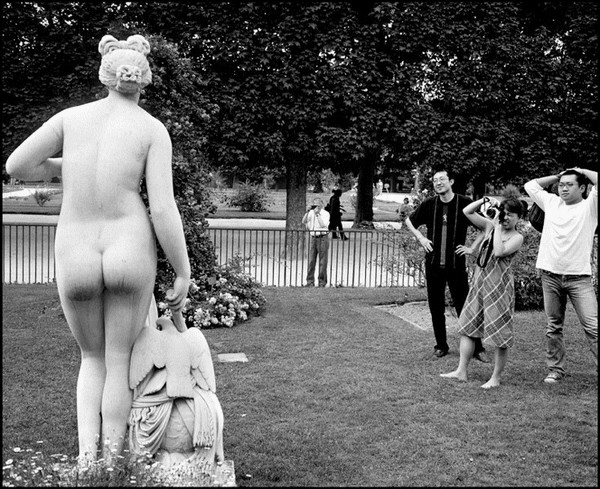
Thomas was able to make of his sensitivity and the precepts of the "silver print" philosophy, a force to fit all sizes: Panoramic, Polaroid, medium format, black and white, color, digital, silver print.
Since 2009, Thomas Salva is also recognized as writer-director and videographer. Alongside the journalist Olivier Lambert, he developed documentary projects for the web, television and film, where his leg and his eye reveal animated images. Projects, Brèves de trottoirs and La Nuit Oubliée – 17 octobre 1961 have received numerous awards in France and abroad.
Thomas Salva is co-founder of the creative laboratory audiovisual Lumento.
Our advice: invest! The signed and numbered 30 x 40 cm prints are sold between £400 and £600: a price that is still very accessible before the next "first" high exhibition. For more information, please contact the artist directly at Thomas@lumento.fr
Copyright : courtesy of Thomas Salva
» More

 From 1954 to 1958, Ingo Maurer studied the graphic arts in Munich. He went to work a few years in New York and California before founding his studio Design M in Munich in 1963 and devote himself to the design of light units.
The career of the designer begins with a single bulb hanging from the ceiling ... First great inspiration. Follows his first table lamp: Bulb, a giant crystal lamp in chrome that quickly became cult. » More

 February 20, Versailles informed us have received an extraordinary gift: a Japanese lacquer commode performed by Gaudreaus for the bedroom of Louis XV in the Chateau de Choisy.
Let’s focus on this piece, the donation and the intricacies of this donation.
The commode
Curved in black and gold Japanese, with red floral motifs and European lacquer or vernis Martin (see our previous article), opening in front by two large drawers without apparent traverses and two side cabinets. It rests on cabriole legs and wears a red marble top.
It has outstanding ormolu rocaille bronzes decorated with palms, reeds, shells, concretions and windings.
Our furniture was delivered in 1744 by the marchand mercier Thomas-Joachim Hébert for the bedroom of King Louis XV at the Chateau de Choisy and was executed by the cabinetmaker Antoine Robert Gaudreaus. The chamber of Louis XV at Versailles was also furnished with a commode by Gaudreaus, delivered in 1739, inlaid kingwood and whose bronzes are signed Caffieri.
Lacquers from Japan were at the time, a very rare and particularly expensive product. To perform this commode, the garde meuble royal provides Hébert a lacquer screen, bought by Louis XIV, he cut up and of which he made thin the lacquer panels so they can be plated on the frame of the commode. This step is particularly difficult because the lacquer is very fragile.
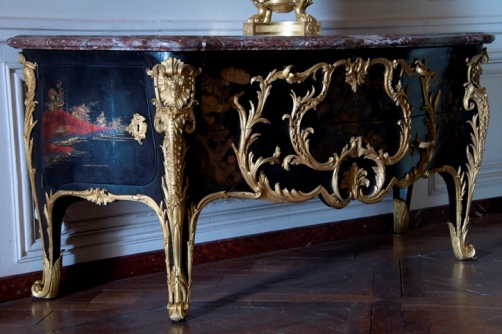 The donation
The donation
The commode remains at the Chateau de Choisy until it was unfurnished then passes into the rooms of Madame Elisabeth and Queen Marie-Antoinette at Chateau de Saint-Cloud finally sold during the revolutionary sales.
It reappears in Egypt in the early twentieth century and passes in Italy by an American collector before being acquired in auctions in Italy in 1987 by Edmond J. Safra.
It is the widow of the latter, which through its philanthropic foundation has donated it at Versailles. This donation is not the first of the Edmond J Safra foundation; it has previously given to the Louvre two terrines and stands in silver executed by the goldsmith Balzac from the famous Penthièvre Orleans service as well as watercolors and manuscripts.
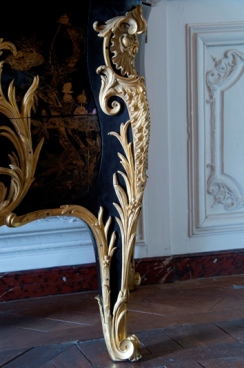 The story behind
The story behind
This donation was not made without problems. Announced in 2009-2010, the services of Italian cultural goods refused to grant permission to leave their territory to the commode they saw as a national treasure when it has not in any meaning for Italy own heritage . It was not executed by neither an Italian artist, nor an Italian residence and arrived in the peninsula late, around 1960. It took the intervention of many curators and diplomacy to our piece of furniture can join the French public collections after more than three years of negotiations.
Let us hope that the quality of this commode gives new impetus for the restoration of certain rooms of Versailles and it will generate more donations from major collectors.
» More

 Auguste Rodin (1840-1917) is probably the most famous French sculptors of the second half of the nineteenth century and early twentieth century. His eponymous museum deals with the highlighting and protection of his work.
If the sculptures in marble or plaster at auction are extremely rare, it is still possible to acquire a bronze edition of one of his sculptures.
Auguste Rodin worked in his early years with the greatest sculptors of his time as Carrier-Belleuse or Joseph Van Rasbourg.
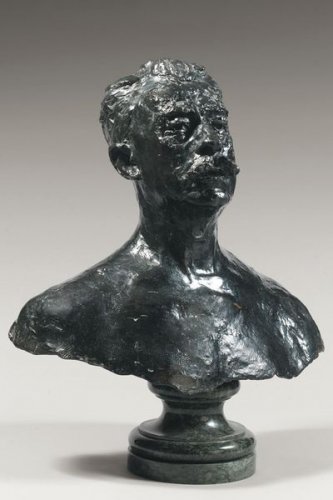 © SVV Aguttes © SVV Aguttes
The Paris Exposition Universelle of 1900 marked the zenith of its glory. Rodin is allowed to have a private house in which he sets 170 sculptures, drawings and watercolours.
He formed in his workshop some of the great sculptors of the twentieth century among which may be mentioned Brancusi, François Pompon, Antoine Bourdelle or Camille Claudel.
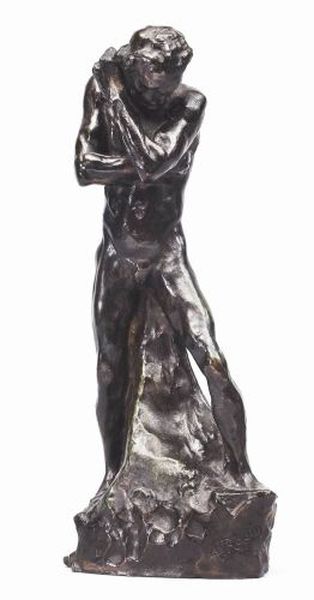
© SVV Artcurial
» More

Sera
Published : February, 04 2013
 In November 2012, the magazine Art Absolument dedicated Sera as one of the 101 best contemporary artists in France over the last ten years.
» More

 Sunday, February 9 SVV Guillaume Le Floc'h, assisted by our Cabinet of expertise for furniture and works of art, will auction old masters, modern and contemporary paintings, furniture and works of art from the XVII, XVIII and nineteenth centuries as well as ceramics.
Lot 44 is an oil on canvas entitled "Electra" executed by Georges Mathieu (1921-2012). This painting is signed and dated 70 on the lower right and titled on the back of the canvas. With two small recesses and rubbings, this canvas is expected between 25 and 35,000 Euro.
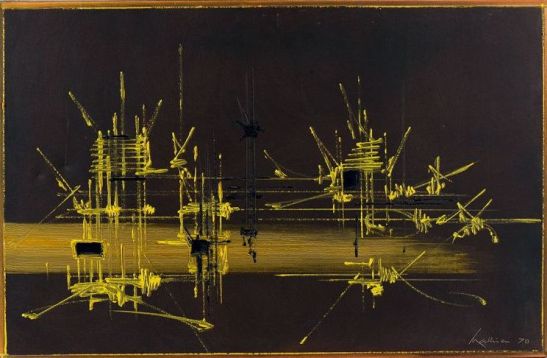
Lot 79 is a prototype iron sculpture titled "Design of Intention" executed by the famous Chilean artist Roberto Matta (1911-2002). Painter, sculptor, Matta was a member of the surrealist movement. Donated by the artist to the stepfather of the seller, our sculpture is expected between 6,000 and 8,000 Euro.
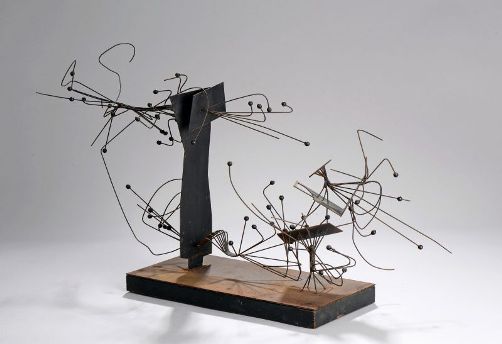
After contemporary art, we turn to China, with lot 112. It is a rare vase baluster in white nephrite stained rust carved in low relief of flowers and pines. The neck is decorated with two handles in the form of chimera with rings. This vase dating from the eighteenth century is estimated at between 20 and 30,000 Euro despite the lack of its cover.
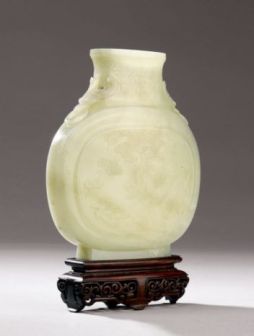
Finish our selection with two French works of art from the late nineteenth century.
Lot 216 is an exceptional clock in ormolu and marble. The black and white circular enamel dial with roman and Arabs numbers is signed "A. Beurdeley / Paris". The movement is signed "S. Marti et Cie ". Made in Paris, c.1889 by Alfred-Louis-Emmanuel (Alfred II) Beurdeley (1847-1919), our clock is expected between 4 and 6,000 Euro. Note that a similar clock is kept in the Study of the Emperor Napoleon III the Château de Fontainebleau. Main image.
Lot 220 is a rare pair of bronze candlesticks with brown patina and leaves decoration. Our pair of lamps is signed by Barye. The latter is especially known for its animal bronzes but also executed a few items of furniture such as candlesticks. The pair is estimated between 2 and 3,000 Euro.
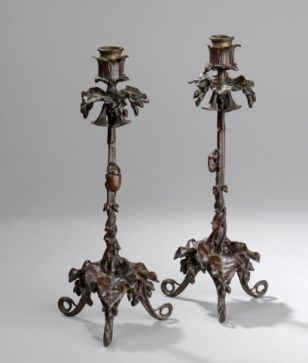
Do not worry, the sale also includes a large number of lots, estimated between 100 and 1,500 Euro. Do not hesitate to consult the online catalogue.
Informations:
Where: hôtel des Ventes de Saint-Cloud - 1ter boulevard de la République – 92210 Saint-Cloud. » More

 An author who determines his life Karen Blixen An author who determines his life Karen Blixen
It is the reading of Out of Africa at 17 that comes radically overturn the lives of Peter Beard. He falls deeply love with Africa. » More
|